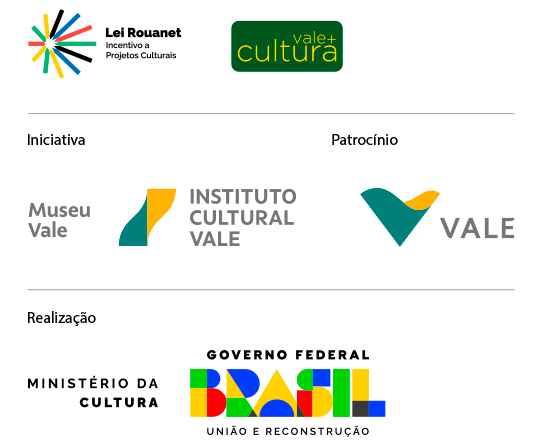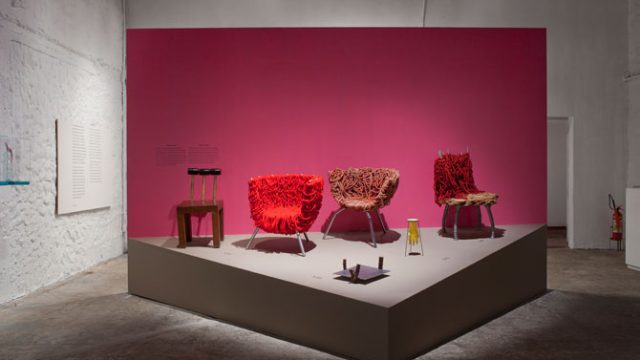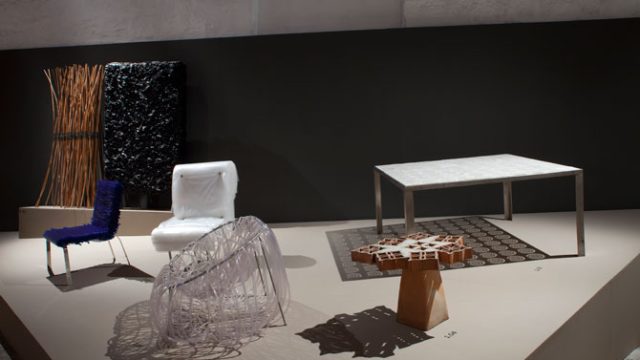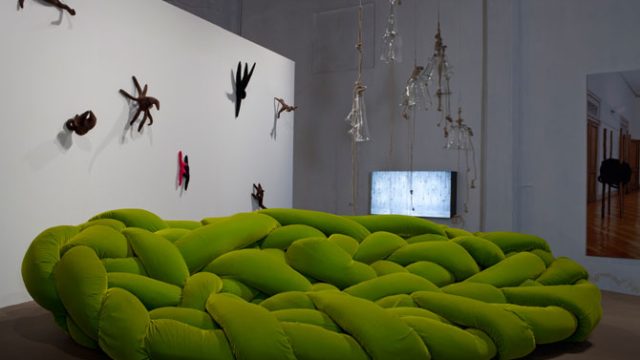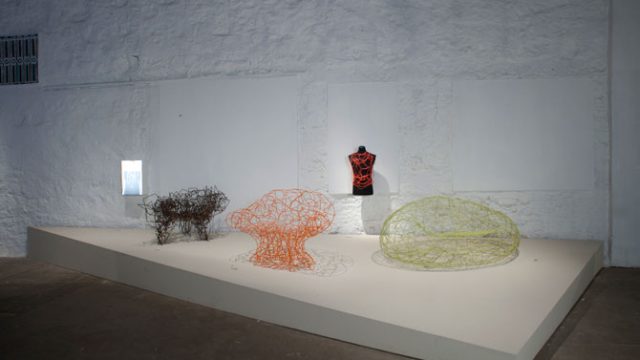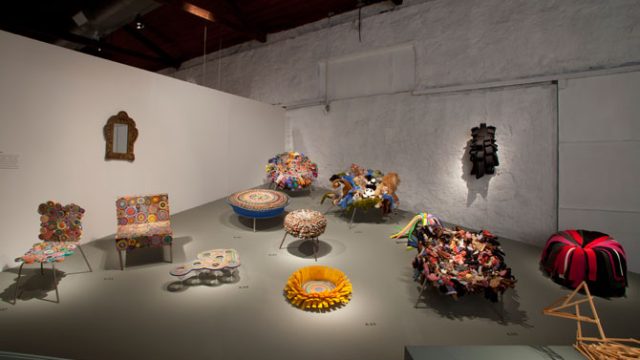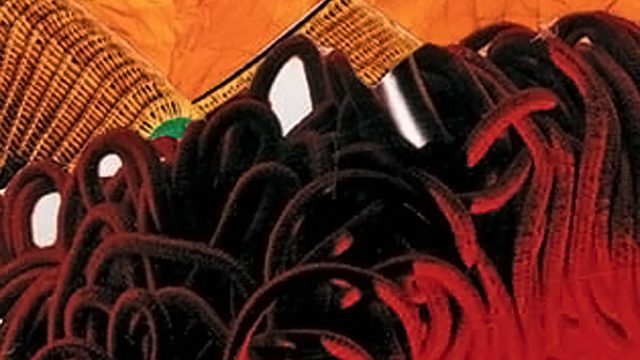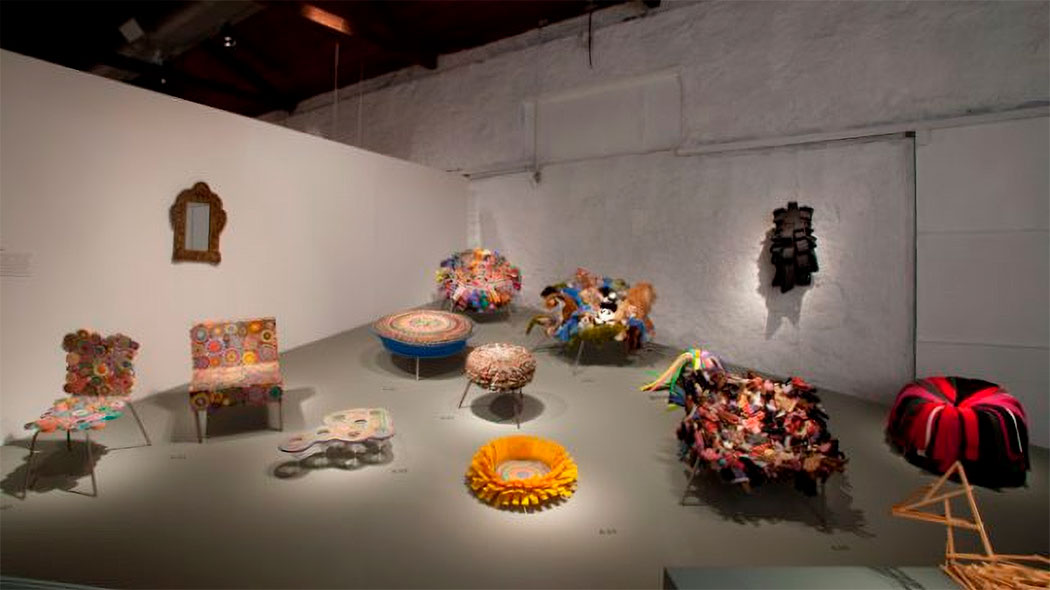
“Anticorpos (antibodies)” focuses on the body of work by the brothers Fernando and Humberto Campana – encompassing visual arts, furniture pieces, jewelry, and large-scale installations – elucidating their strategies, sources of inspiration, and the diverse approaches to design that they employ. While Humberto creates his objects as a self-taught craftsman and artist, Fernando contributes as an experienced architect. Together, they disregard all conventions of traditional design, play with the notion of functionality, and shape their poetic objects from contradictory realities.
Considered central figures in international design, the Campana Brothers have a visual language anchored in Brazil, featuring an extraordinary contrast of colors, shapes, and materials. Using entangled or interwoven wires, cotton, plastic, copper, colorful patches, and prints in exuberant forms, they transform a chair into a work of art. They see design as a cultural appropriation of influences, and the success of their creations transcends the boundaries between art and design, creating aesthetic icons in the form of unique pieces and limited editions – the authorial design.
Curator
Mathias Schwartz-Clauss is a senior curator at the Vitra Design Museum in Germany. He studied Art History and Philosophy at the Universität Trier and Ruhr-Universität Bochum, where he graduated in 1991.
He conceived and organized exhibitions for artists such as Ron Arad, Borek Sipek, Thonet, Charles and Ray Eames, Frank Lloyd Wright, Masterpieces from the Vitra Design Museum’s Collection, Jean Prouvé – and for the Pinacoteca Agnelli in Turin, Italy, an exhibition of Alexander von Vegesack’s private design collection. He curated retrospectives of Rudolf Steiner and the Campana Brothers. Mathias Schwartz-Clauss is a consultant for the summer academy in Boisbuchet, France. He contributes to various design publications and serves as a guest lecturer at educational institutions worldwide.
Release
Vale Museum presents “Anticorpos”, the first retrospective of the Campana Brothers in Brazil
Starting on April 20, the most comprehensive retrospective of the Campana Brothers can be experienced in Brazil. The exhibition, featuring 200 works (from 1989 to 2009), was organized by the Vitra Design Museum, Weil am Rhein, Germany, where it was showcased until February 2010, subsequently touring other important cultural centers in Europe. The curator of “Anticorpos” is Mathias Schwarz-Clauss, the curator of Vitra, and the production in Brazil is by ARTVIVA Produção Cultural.
“Anticorpos” focuses on the entirety of the works of brothers Fernando and Humberto Campana – including visual arts, furniture pieces, jewelry, and large-scale installations – elucidating their strategies, sources of inspiration, and the varied approaches to design they employ. While Humberto creates his objects as a craftsman and self-taught artist, Fernando participates as an experienced architect. Together, they defy all conventions of traditional design, play with the notion of functionality, and form poetic objects from contradictory realities.
Considered central figures in international design, the Campana Brothers’ visual language is anchored in Brazil, with an extraordinary contrast of colors, forms, and materials. Using tangled or interwoven wires, cotton, plastic, copper, colorful patches, and exuberant patterns, they transform a chair into a work of art. They see design as a cultural appropriation of influences, and the success of their creations transcends the boundaries between art and design, creating aesthetic icons in the form of unique pieces and limited editions – the authored design.
The retrospective virtually presents the entirety of the Campana Brothers’ works, including private collections and pieces from the Studio Campana’s own collection. It also showcases pieces created especially for “Anticorpos”, developed in collaboration with the Vitra Design Museum. Among them, there are experiments with papier-mâché and a series of paper collages that announce each theme of the exhibition in the order these themes were grouped. Additionally, a variety of curious objects collected by the Campana Brothers over many years allows the public to decipher their personal world. A film featuring images from the ballet “Metamorphoses”, for which the Campana Brothers designed the sets and costumes, completes the exhibition. The ballet, inspired by Ovid’s mythological texts and choreographed by Frédéric Flamand, was filmed during a performance at the Théâtre National de Chaillot in Paris in 2008.
The Exhibition
“Anticorpos”, which will occupy the entire exhibition hall of the Vale Museum, will be divided into nine themes:
Fragmentos (Fragments)
The fragmentation and reassembly of an object are well-known artistic techniques. The Campana Brothers utilize this approach to trace the internal and external disarticulation of their early terracotta sculptures. With the Favela armchair from 1991, the main idea became a tribute to improvisation and ephemerality.
Objetos Trouvés (Found Objects)
In 1950, Italian designer Achille Castiglioni already reinterpreted everyday objects and materials, taken from contexts outside of design, using them to create new works. However, Castiglioni’s interest was in the functional effects resulting from these reinterpretations. The Campana Brothers, on the other hand, favor the artistic concept more akin to surrealism and the fetishization of objects in indigenous societies: the stories contained in the objects and materials leave the new piece impregnated with additional meanings.
Nós (Knots)
Numerous designs by the Campana Brothers are exclusively developed from linear structures, akin to three-dimensional drawings. These metal wire designs don’t appear as outlines of a chair, screen, or table; the metal wires are used as raw material and repeated continuously, piled up or interwoven until a usable object emerges. Objects created in this way resemble impenetrable vegetation in virgin forests.
Varetas (Sticks)
The series of objects the Campana Brothers constructed with bundles of sticks seems to reflect the artificial chaos created by humans – an impression also evoked by titles such as “Batuque” or “Blow up”. This series began with one of Humberto’s early works with metal: the “Grelha” sculpture, resembling an oversized “grill” chair, playfully commenting on its design.
Híbridos (Hybrids)
In their “Mistura” series, starting in 1997, the Campana Brothers juxtaposed organic and inorganic, natural and industrial, warm and cold materials. In the “Transplásticos” series of 2007, they revisited this approach by interweaving wicker with unusual materials. Humberto had already used the tridimensional malleability of wicker in his early handmade objects; now, the material is present in lighting fixtures and seats, creating large-scale figurative sculptures.
Planos Flexionados (Flexed Plans)
The Campana Brothers’ interest in combining artistic approach with industrial production is represented by a group of objects with clear, geometric forms that contrast with the rest of their work. Nevertheless, structural perfection has always been a guiding principle for their works. Some of these “rationally” constructed objects – all showing a formal affinity with Oscar Niemeyer’s modernism – have already reached the final stage of development for mass production.
Objetos de Papel (Paper Objects)
Inspired by the cardboard boxes reused and recycled by waste pickers and homeless individuals in São Paulo, the Campana Brothers had the idea of leveraging the transparency of the material, which becomes evident when looking directly through the thin thickness of the cardboard, to create lighting fixtures and screens from this material. Following these initial experiments, they quickly began using cardboard for tables and seats as well. Today, in partnership with the Vitra Design Museum, they are exploring the possibilities of industrially creating objects manufactured from recycled and recyclable paper.
Agrupamentos (Groupings)
One of the recurring techniques of the Campana Brothers is to extract manufactured or found materials from their original context and group them to create a new form from this mass. Even with inexpensive and readily available materials, this method produces an illusion of luxury. The Baroque, rooted in Brazilian culture, along with the excessive growth of tropical flora and the population explosion in Brazil’s metropolitan centers, offers impressive models for this theme.
Orgânicos (Organics)
The natural environment of Brazil – lush yet threatened by predatory exploitation – has been a constant source of regeneration and inspiration for the Campana Brothers since their childhood. The diversity and extremes of tropical shapes and colors are processed into highly ingenious objects that present themselves as organic beings, revitalizing the environment around them. However, within the same theme, some of their early works emerge as mutations generated by contact with the civilization.
The Campana Brothers
Internationally known as the Campana Brothers, Humberto (1953) and Fernando (1961) were born in Brotas, in the interior of São Paulo. Humberto graduated in Law and, armed with his diploma, officially began researching what had interested him since childhood: the infinite possibilities of craftsmanship. In the ’80s, he set up a small studio for handmade products. With a degree in architecture, Fernando was interested in investigating alternative methods for the materialization of design. He studied the communicative and synthesizing power of Le Corbusier and Oscar Niemeyer’s lines, as well as the construction of small-scale objects. After graduating, he interned at the 17th edition of the São Paulo Art Biennial.
In late 1983, Humberto called his brother to help with a large order. Since then, they have formed one of the most awarded duos in contemporary design. They are recognized for suggesting new codes of interpretation for objects and contributing to changes in perspectives on everyday life. Their first joint exhibition was in 1989 at the Nucleon Gallery in São Paulo. The collection of iron chairs was called “Desconfortáveis (Uncomfortable)” a selection of pieces that discussed the artistic aspect, error, and poetry contained in discomfort.
In 2009, marking the tenth anniversary of the exhibition that launched them, the Campana Studio was chosen to celebrate its anniversary at the Vitra Design Museum in Germany, which was also commemorating a decade of existence. The Campana Brothers are now known for their unparalleled and sophisticated technical qualities: the art of design. Their works are exhibited in major museums worldwide, including the Vitra Design Museum in Germany, MoMA in New York, and the George Pompidou Center in Paris. Fernando and Humberto Campana received the Special Museum of Brazilian House Award in 2001 and Designer of the Year from Design Miami in 2008.

Fale conosco
Redes sociais

